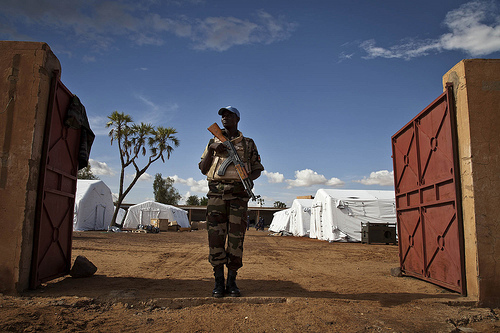Zum Einlesen fürs Bundeswehr-Mandat: der aktuelle Mali-Bericht der UN
Bevor am (morgigen) Mittwoch das Bundeskabinett über die Ausweitung der deutschen Beteiligung am UN-Einsatz in Mali beschließt (faktisch über einen neuen Einsatz, der in den gefährlichen Norden führt), hier schon mal was zum Einlesen zur Situation in dem westafrikanischen Land: Der aktuelle Bericht der Generalsekretärs der Vereinten Nationen zur Lage, vorgelegt am 24. Dezember vergangenen Jahres und jetzt im Internet nachlesbar.
Aus dem United Nations Report of the Secretary-General on the situation in Mali, Kapitel Sicherheit:
While positive steps were taken towards the implementation of the peace agreement by the signatory parties, there was an increase in the number and geographical spread of activities by extremist and terrorist groups and organized crime networks, notably in Mopti, Ségou and Timbuktu regions, as well as in Bamako. The prevalence of improvised explosive devices in northern Mali continued to put the Malian defence and security forces, French forces and United Nations personnel at risk and to seriously constrain the operations of MINUSMA. The Mission therefore continued to require convoy escorts and force protection, despite the absence of fighting between CMA and the Platform following the Anéfis talks and the ongoing efforts by the Government and the signatory armed groups to organize the cantonment process and to put mixed patrols into operation. (…)
The activities of extremist and terrorist groups also continued unabated in
northern Mali, with a total of 28 attacks, compared with 20 attacks during the previous reporting period, targeting MINUSMA using improvised explosive devices or mines. During the reporting period, hostile acts against MINUSMA resulted in the deaths of a total of 2 peacekeepers, 1 civilian staff and 1 civilian contractor, while 18 peacekeepers and 2 civilian contractors were injured. On 24 November, a MINUSMA armoured vehicle in a logistics convoy hit by an improvised explosive device 25 km west of Timbuktu resulted in the first death of a MINUSMA
civilian staff by the use of such a device. On 28 November, six rockets hit the MINUSMA camp in Kidal, killing 2 peacekeepers and 1 civilian contractor and wounding 18 peacekeepers and 2 civilian contractors. Media reports cited a senior Ansar Dine figure claiming responsibility.
MINUSMA convoys remained the primary target of extremist and terrorist
groups and transnational drug traffickers on the main supply routes between Gao
and Tessalit and between Gao and Ménaka (Gao region). On average, two out of three MINUSMA convoys between Anéfis and Gao and four out of five between Gao and Ménaka were hit by improvised explosive devices during the reporting period, damaging or destroying four MINUSMA military vehicles and three civilian-contracted trucks. Measures to counter the use of improvised explosive
devices adopted by MINUSMA, including in-depth training of troops and a revision
of the casualty evacuation procedures, prevented all but one civilian casualty. However, force protection measures, including convoy escort and camp protection, consume approximately two thirds of the Mission’s infantry capacity, seriously hampering the implementation of mandated tasks in spite of elaborate planning and the constant reprioritization of tasks, as well as the investment of significant financial and other resources.
Zusammen mit dem (morgigen) Mandat dann viel Stoff für die Debatte über den Einsatz bis zum Beschluss des Bundestages, voraussichtlich Ende Januar.
(Archivbild August 2013: A UN peacekeeper from Niger patrols the area where UN peacekeepers from Ghana are setting up tents in Gao, 1200 km North of Bamako, Mali. MINUSMA establishes a 100 men camp HQ to expand its operations in the region – Photo MINUSMA/Marco Dormino)




„On average, two out of three MINUSMA convoys between Anéfis and Gao and four out of five between Gao and Ménaka were hit by improvised explosive devices during the reporting period, damaging or destroying four MINUSMA military vehicles and three civilian-contracted trucks.“
Das ist übel…
Anéfis nach Gao sind 241km
Gao nach Ménaka sind 320km
Diese Entfernungen zu überwachen oder zu sichern ist völlig jenseits der Möglichkeiten der geplanten Kräfte.
Das wird spannend – hoffentlich müssen nicht unsere Logistiker diese Strecken regelmäßig abfahren.
pi
Das nächste unüberlegte und strategielose Abenteurer….
Wenn man die Aufgaben betrachtet, hat man das Gefühl, dass die Teile MINUSMA stark eingeschränkt sind, in der eigentlichen Unterstützung der Regierungsstreitkräfte.
Da bin ich mal auf den Auftrag der geplanten ISR Kp gespannt.
Strategielose Abenteuer???
Strategien hatten wir genug in Afghanistan , nur leider stand uns immer die eigene Humanität im Wege!!!
Der Einsatz von Streitkräften muss für die Entscheider auch immer mit dem Einsatz von Militärischer Gewalt Zusammenhängen können .
Das jedoch wird meist ausgeblendet. Es geht hier um nicht weniger als den Kampf gegen Terroristiche Kräfte und OK. Beides hängt zusammen und ist nicht getrennt zu betrachten.
Der Einsatz von Aufklärungskräften ist richtig, bleibt aber nutzlos wenn mit der gewonnenen INTEL nicht der nächste Schritt erfolgt.
Nein, es geht bei MINUSMA nicht um Counter-Terrorism. Die Resolution 2227 (2015) des UN-Sicherheitsrates ist eindeutig: Mali ist als souveräner Staat verantwortlich für seine Sicherheit. MINUSMA unterstützt „nur“ bei der Einhaltung des Waffenstillstandes und den Friedensverhandlungen zwischen dem malischen Staat und den sogenannten unterzeichnenden Gruppen. Dabei gelten die Grundlagen des Peacekeeping: Unparteilichkeit, Zustimmung aller beteiligten Parteien sowie Verzicht auf den Einsatz von Gewalt außer zur Selbstverteidigung oder zur Verteidigung des Mandats.
Die Resolution sagt aber auch ausdrücklich was zu Counter-Terrorism: „(…) Welcoming the continued action by the French forces, at the request of the Malian authorities, to deter the terrorist threat in the North of Mali (…)“
@Jesus Messerschmitt
OK und wer sagt jetzt den Konfliktparteien, dass MINUSMA Unpaarteilich und so ist?
Schließlich wird MINUSMA bereits regelmäßig das Ziel von Angriffen.
Auch mit defensiven Auftrag kann man in Gefechte geraten. Genau so war ISAF für die DEU-Kräfte bis 2009.
pi
Also wieder mal ein Auftrag der UN ohne ein richtiges militärisches Konzept. Diese Einsätze hatten schon immer, wenn es militärisch eng wurde, nicht die notwendige Durchschlagskraft. Zu viel „zivile Entscheidungsträger “ Ich erinnere nur an Runda und dem Balkan (Srebenica). Die Entlastungen der FR Kräfte ist ja nur bedingt der Fall. Hier werden auch Kräfte der NDL und andrer Staaten abgelöst. Eine offensive Unterstützung der malischen Kräften in dieser geringen Truppenstärke ist nicht möglich. Also wieder mal Lagerwache, Convoybegleitung und Bluebox Patroullien……
@Messerschmitt
In der Resolution ist von Neutralität gegenüber „unterzeichnenden Gruppen“ die Rede. Al-Kaida und IS haben sicher nicht unterzeichnet und daher ist auch keine Neutralität geboten.
@Wait&C
Neutralität schließt aber eine (in-) direkte Unterstützung einer Konfliktpartei im Rahmen des Mandats aus (also z.B. der malischen Armee).
Eine saubere Trennung in „gute“ und „böse“ westliche Soldaten findet beim Gegner natürlich nicht statt.
@ Fritz: Terrorismus und Organisierte Kriminalität bedürfen sehr wohl einer getrennten Betrachtung. Man kann beides nicht mit identischen Maßnahmen nachhaltig bekämpfen.
Und ja: Wieder ein strategieloses Abenteuer … Die AFG-Strategien, die es gegeben haben soll … die würden mich jetzt aber mal wirklich interessieren. ;)
@all
MINUSMA arbeitet mit der Malischen Armee zusammen und führt auch gemeinsame Operationen durch.
Operation Hydra:
http://www.bfmtv.com/international/mali-france-engage-une-nouvelle-operation-militaire-630966.html
„This could include the conduct of operations on its own or in cooperation with the Malian defence and security forces.“
http://www.un.org/en/peacekeeping/missions/minusma/background.shtml
Also nix mit Neutralität á la Balkan 90er.
pi
@all
Nach dem Kabinettsbeschluss zum Mali-Einsatz gibt’s jetzt einen ausführlichen neuen Thread mit Auszügen aus dem Mandatstext; bitte die Debatte dort weiterführen.
@Müs_Lee
“ Terrorismus und Organisierte Kriminalität bedürfen sehr wohl einer getrennten Betrachtung“
Evtl ist gerade die getrennte Betrachtung die Ursache für den erfolglosen Kampf gegen den Terrorismus.
Terrorismus ist immer organisierte Kriminalität aber nicht jede organisierte Kriminalität ist Terrorismus.
Wir bekämpfen in Deutschland den Terrorismus sehr erfolgreich mit den Mitteln der Polizei/BKA und BND. Bei der organisierten Kriminalität und dem noch unorganisiertem Terror von rechts haben wir wohl noch Nachholbedarf.
Hätten wir die RAF mit militärischen Mitteln, unter Inkaufnahme von hohen Kollateralschäden geführt, hätte sie es evtl bis heute gegeben.
@Zimdarsen
Man ist sich ja nicht einmal klar, ob counter insurgency oder counter terrorism auf der Tagesordnung stehen soll.
Wie hätten Sie die RAF mit militärischen Mitteln bekämpfen wollen?
@Zimdarsen:
Nein, es ist insofern schon nicht gleich bekämpfbar, weil beide Ideologien völlig verschiedener Natur sind! Terrorismus richtet sich gegen Staat und Gesellschaft. OK richtet sich nach der besten Verdienstmöglicheit!